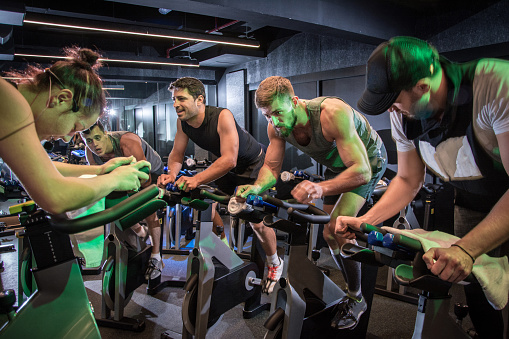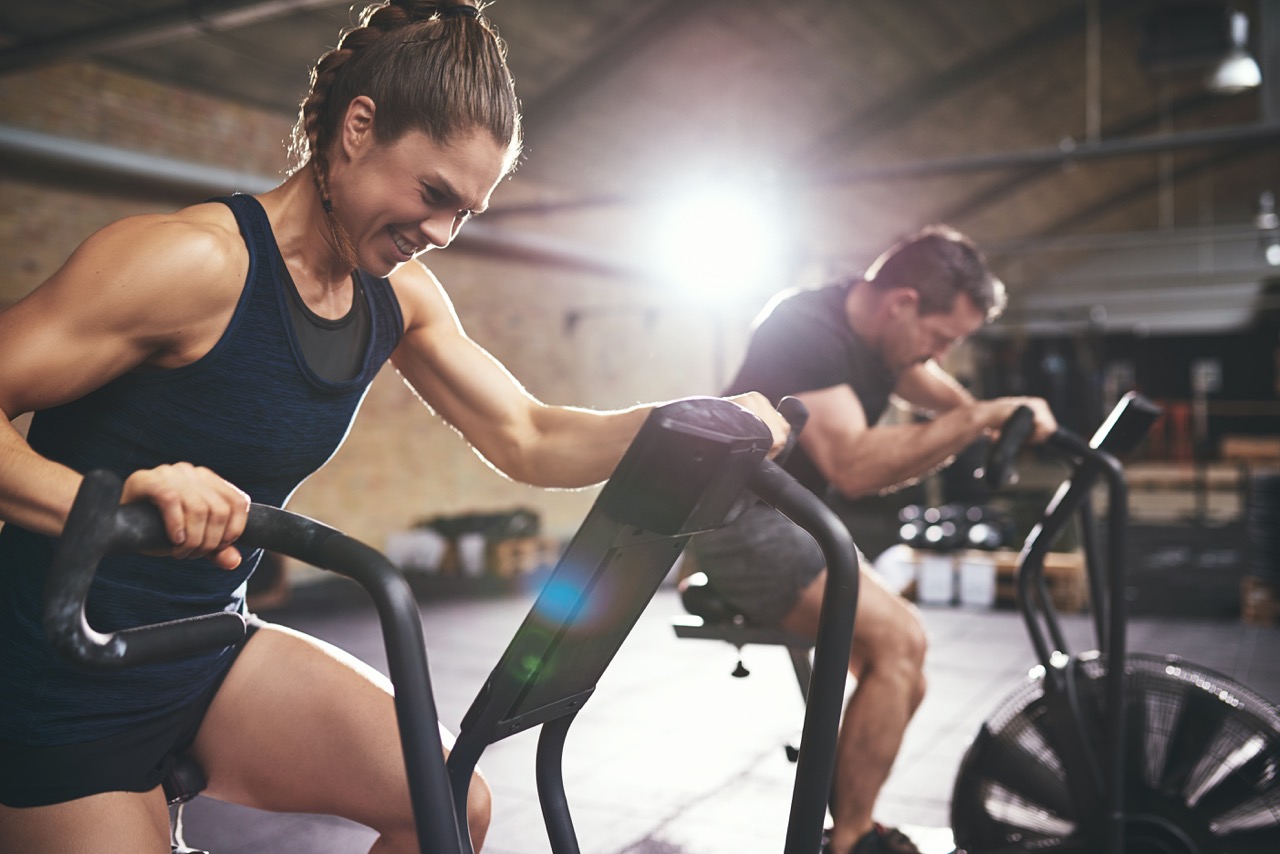Science Behind Using HIIT For Fat Loss

Cardiovascular activity has long been used as a tool for health as well as weight loss. Dreaded by some and loved by others, cardio is a key piece in all training plans for its role in cardiovascular well-being and athletic performance across all sports, and increasing your caloric output through cardio is a beneficial way to tip the scale in your favour—literally. You can employ numerous cardio options and methods to reach your goals, ranging from low-to-moderate intensity steady state (LISS) all the way to high-intensity interval training (HIIT). All forms come with their own benefits. People within the fitness world have developed very strong opinions about each of the various types. Some folks swear that HIIT is the best way to see results, while others view LISS as the most productive. But what does science say?
How High Can You Go?
 High-intensity interval training is composed of two intervals (or phases) of work, which we’ll refer to as the high interval and the low interval. During the high interval, athletes work to their maximum potential (intensity), and during the low interval, they recover. The cornerstone of HIIT is the work put into the high intervals, so the low interval must allow enough recovery that athletes are able to put their maximum effort into the next high interval. Without adequate recovery, the performance during the high interval won’t reach the point needed to reap the full benefits of the session. Measuring work intensity, such as what is done in the intervals, is often done through VO2 max. VO2max refers to an individual’s maximum rate of oxygen consumption during exercise, expressed in litres of oxygen per minute. Because this measurement requires lab equipment, many people are unaware of their true VO2 max. Regardless of whether you have an official measurement, athletes can appropriately judge their output as a rate of perceived effort and thus can execute interval training efficaciously simply by being instructed to work at a certain percentage of their VO2 max. For example, performing at 40 to 50 percent of one’s VO2 max would be a light jog or fast walk, whereas 80 to 100 percent would be a sprint. The structure of HIIT sessions can vary in their work-to-rest ratios. The traditional approach is to place more emphasis on the work portion by allowing for a longer recovery interval, such as a 1:2 ratio. On the other hand, some plans may have a 2:1 ratio, where the high-intensity phase lasts twice as long as the low interval, putting more emphasis on your elevating the all-out interval. These factors can depend on your level of fitness, personal goals, and individual preference. That is, by improving your fitness over time, you can lengthen your work ses-sions and reduce the time of your recovery periods.
High-intensity interval training is composed of two intervals (or phases) of work, which we’ll refer to as the high interval and the low interval. During the high interval, athletes work to their maximum potential (intensity), and during the low interval, they recover. The cornerstone of HIIT is the work put into the high intervals, so the low interval must allow enough recovery that athletes are able to put their maximum effort into the next high interval. Without adequate recovery, the performance during the high interval won’t reach the point needed to reap the full benefits of the session. Measuring work intensity, such as what is done in the intervals, is often done through VO2 max. VO2max refers to an individual’s maximum rate of oxygen consumption during exercise, expressed in litres of oxygen per minute. Because this measurement requires lab equipment, many people are unaware of their true VO2 max. Regardless of whether you have an official measurement, athletes can appropriately judge their output as a rate of perceived effort and thus can execute interval training efficaciously simply by being instructed to work at a certain percentage of their VO2 max. For example, performing at 40 to 50 percent of one’s VO2 max would be a light jog or fast walk, whereas 80 to 100 percent would be a sprint. The structure of HIIT sessions can vary in their work-to-rest ratios. The traditional approach is to place more emphasis on the work portion by allowing for a longer recovery interval, such as a 1:2 ratio. On the other hand, some plans may have a 2:1 ratio, where the high-intensity phase lasts twice as long as the low interval, putting more emphasis on your elevating the all-out interval. These factors can depend on your level of fitness, personal goals, and individual preference. That is, by improving your fitness over time, you can lengthen your work ses-sions and reduce the time of your recovery periods.

Intensity Is Key
An individual’s fitness level is a major factor in applying HIIT cardio appropriately. When done properly, HIIT is incredibly challenging and requires a high level of fitness to complete. Don’t let the short duration fool you; it will be the most difficult 15 minutes of your gym time. The level of intensity needed in the high interval is taxing on the central nervous system (CNS). The CNS is affected by high-intensity work, whether that involves lifting weights or cardiovascular activity. To recover properly, it needs about 48 hours between intense sessions, so you wouldn’t want to do HIIT training daily. So, much as you need to rest a muscle group for a couple of days before training it with weights again, the same approach should be taken with HIIT cardio. Smart programming of any fitness plan is necessary, and with the level of intensity required for HIIT, it’s no exception.

Benefits Of HIIT
HIIT is recognized for its numerous benefits, not only in athletic performance, but also with overall health. No one can deny that cardio is most commonly used in an effort to lose body fat. If this is your end goal, you likely want to reach it as fast as possible, and HIIT is your best bet here. One of HIIT’s greatest benefits isn’t just the calories you burn during your workout but in its ability to keep the body burning calories for longer after your workout, a large advantage for weight loss. Essentially, that can be seen by an elevated metabolism for as long as 24 hours after you train; your body is still giving off heat during that time, and you do not get that with low-intensity training. While traditional steady-state cardio will burn calories during the workout, the effect quickly drops off once you stop exercising. On the other hand, following a HIIT session, the body will continue to burn calories at a higher than average rate for up to 24 hours. This is scientifically known as excess post-exercise oxygen consumption (EPOC).
What Is EPOC?
This refers to the energy expenditure that occurs following exercise. Strenuous exercise results in muscle cells requiring extra oxygen to restore physiological and metabolic factors back to their baseline. HIIT cardio taxes the muscles to the point that higher EPOC values are  evident, especially in comparison to steady-state cardio. In this regard, HIIT cardio causes similar reactions as weight training, whereby the muscle tissue requires repair and those processes boost your metabolism. It’s not only the recovery of muscle tissue that’s responsible for the heightened caloric response. Fol-lowing HIIT, other recovery mechanisms are at work that contribute to the increased metabolic effect. The body must work harder than normal to replenish its energy stores (ATP levels), remove lactic acid from the muscle cells, break down the triglycerides in adipose tissue, and support the greater demands on the circulatory system as it works to push nutrients throughout the body. When you’re looking to lose weight, these mechanisms that provide a boost in caloric output will be of obvious assistance. Remember, while the numbers on the treadmill display may not seem overly high, your body is working at a greater capacity for the remainder of the day and even night. You also need to consider this factor when programming your HIIT sessions, as shown below.
evident, especially in comparison to steady-state cardio. In this regard, HIIT cardio causes similar reactions as weight training, whereby the muscle tissue requires repair and those processes boost your metabolism. It’s not only the recovery of muscle tissue that’s responsible for the heightened caloric response. Fol-lowing HIIT, other recovery mechanisms are at work that contribute to the increased metabolic effect. The body must work harder than normal to replenish its energy stores (ATP levels), remove lactic acid from the muscle cells, break down the triglycerides in adipose tissue, and support the greater demands on the circulatory system as it works to push nutrients throughout the body. When you’re looking to lose weight, these mechanisms that provide a boost in caloric output will be of obvious assistance. Remember, while the numbers on the treadmill display may not seem overly high, your body is working at a greater capacity for the remainder of the day and even night. You also need to consider this factor when programming your HIIT sessions, as shown below.

Science Of HIIT
If weight loss isn’t your prime concern, HIIT can benefit you in other ways, namely your fitness level, heart health, and athletic performance. The body adapts and grows from the stress we put on it in the form of training, and cardio is no exception. Through physiological cardiovascular changes, such as increases in heart stroke volume (the amount of blood pumped by the heart) and improvements in VO2 max, the body becomes better equipped to handle the demands of HIIT. In fact, in some studies, stroke volume was found to improve by 10 percent over a group performing steady-state cardio, and VO2 max increases of 15 percent were seen. With these outcomes, athletic tasks —whether on a treadmill, court, or field—would become easier. Because of these physiological changes, it’s important to continue to alter the structure of your HIIT sessions to ensure you continue making progress. That relies on the same mechanism you use with weights: progressive overload. This can be done by lengthening your high intervals or shortening your low intervals as the workout becomes less challenging. A final benefit that can’t be overlooked is the short duration of a HIIT session. The most commonly cited reason that people are unable to reach their health and fitness goals is a lack of time. It’s far easier to fit three 15-minute HIIT sessions (excluding low-intensity warm-up and cool-down) into your week than five or six lengthy steady-state cardio sessions, which could last around 45 minutes each. When comparing numbers across a week, HIIT may require approximately 45 minutes of active work, with steady state taking up over three hours of your free time! In today’s hectic society, time is our greatest commodity, earning HIIT another bonus point.
—whether on a treadmill, court, or field—would become easier. Because of these physiological changes, it’s important to continue to alter the structure of your HIIT sessions to ensure you continue making progress. That relies on the same mechanism you use with weights: progressive overload. This can be done by lengthening your high intervals or shortening your low intervals as the workout becomes less challenging. A final benefit that can’t be overlooked is the short duration of a HIIT session. The most commonly cited reason that people are unable to reach their health and fitness goals is a lack of time. It’s far easier to fit three 15-minute HIIT sessions (excluding low-intensity warm-up and cool-down) into your week than five or six lengthy steady-state cardio sessions, which could last around 45 minutes each. When comparing numbers across a week, HIIT may require approximately 45 minutes of active work, with steady state taking up over three hours of your free time! In today’s hectic society, time is our greatest commodity, earning HIIT another bonus point.
The FITT Of HIIT
When programming HIIT, much like other training programs, the FITT principle needs to be addressed. Frequency, intensity, time, and type (FITT) are all factors to consider when creating a safe and effective plan.

1. FREQUENCY. Because of its intense nature, HIIT shouldn’t be used daily. As noted above, you must allow time between sessions for your body, including the CNS, to recover. Additionally, this will help your body manage stress levels and keep your immune system healthy so you don’t miss any training sessions. Recommendation: Do two or three HIIT sessions per week. On the other days, modest amounts of steady-state cardio can be included to complement HIIT.
2. INTENSITY. There needs to be a marked difference in output between the high and low intervals to get the full benefits of HIIT. Recommendation: The high interval should be 80 to 100 percent VO2 max with the low interval around 40 to 50 percent VO2 max. That is, make the high interval a near all-out effort and the low one fairly easy (but in no way should you simply stop).
3. TIME. Total time for a HIIT ses-sion will vary based on how the intervals are structured. Generally, a HIIT session can be completed in approximately 15 minutes, including a warm-up and cool-down. Recommendation: Depending on your fitness level, high intervals of 10 to 15 seconds and low intervals of two to three minutes, completing four to six rounds, can be a starting point. Adjust durations as needed. Always include a warm-up and cool-down to allow your body to adjust to the stress.

4. TYPE. The most effective HIIT equipment includes a Spin bike or a treadmill. If you have access to a non-motorized treadmill, it would be the optimal choice as there is less lag time when switching between intensities and you’re able to fully control the work level. You can also try an elliptical trainer. Recommendation: Use a Spin bike, elliptical or treadmill to work at 80 to 100 per-cent VO2 max output.
SCIENTIFIC REFERENCES
Astorino TA, Allen RP, Roberson DW, Jurancich M. Effect of high-intensity interval training on cardiovascular function, VO2max, and muscular force. J Strength Cond Res. 2012 Jan;26(1):138-45.
Børsheim E, Bahr R. Effect of exercise intensity, duration and mode on post-exercise oxygen consumption. Sports Med. 2003;33(14):1037-60.

